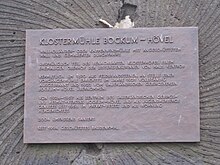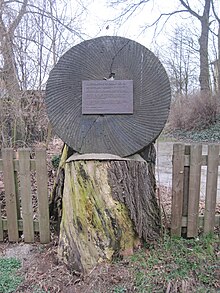Klosterhof (Bockum-Hövel)
The cloister is the peasantry Hölter. This belongs to the Hövel district , today's Hamm-Bockum-Hövel district of the city of Hamm . The monastery mill that once belonged to the property has been a listed building since April 21, 1994.
location
The monastery courtyard is located north of the Hamm-Münster railway line , a few hundred meters west of the Bockum-Hövel train station and from Haus Ermelinghof on Klostermühlenweg 40 (formerly: Klosterhof 20), which is named after him.
state of construction
The monastery courtyard area was once a fortified place, that of earthen walls and moats was surrounded. The ramparts have now been removed, and the moats fed by the Geinegge are still partially there. Two gatehouses on the former drawbridge bear witness to the house's former strength. A windmill, the former youth hostel, belongs to the monastery courtyard; Today the farm and mill have different owners.
history
The exact date of origin of the monastery courtyard is unknown. During excavations, iron lance tips and small horseshoes made by mules have been found. This led to the assumption that a Roman fort and / or an important arsenal could have been here.
It is possible that the property already existed in its later form after the Christianization of Westphalia by Liudger from 804, at the latest around the year 900. In the 10th century, the property is said to have been owned by the Cölestiner .
Later the Cistercian women settled there. What is certain is that the monastery courtyard was a main or official court of the Kentrop monastery . The Cistercian Sisters founded the Marienhof Monastery (Curia sancte Maria) within the city walls of Hamm in 1272. Since the monastery had been threatened by fires several times and there was also resistance to its expansion in Hamm, it was finally moved in front of the city walls. The Cistercian nuns moved into the land assigned to them on March 11, 1290, on which Kentrop Monastery was built, on March 11, 1296. A monastery school was established by Kentrop in the monastery courtyard in Hölter . One of his tasks was to collect taxes from the other courts belonging to the monastery. These include Noldes, Kleine Rogge and Holtersdorf in the Geinegge and Hölter farmers and Rogge and Herding (also known as Hering) in the Barsen farmers.
From the Bockum-Höveler Heimatliteratur it is assumed that the Cistercian women were already present in the region at a much earlier point in time. The killing of the Cologne Archbishop Engelbert I of Cologne with the participation of Friedrich von Isenberg led to the destruction of the Isenberg castle and city of Nienbrügge by Adolf I. Graf von der Mark . The women in the monastery are said to have sought protection “inside de Muren tom Hamme”, the city walls of Hamm . Even later, they are said not to have returned to the monastery courtyard, because in the course of the inheritance dispute between Adolf I. Graf von der Mark and Dietrich von Altena-Isenberg , the so-called Isenberger Wirren (1232 to 1243), the neighboring farmers Hölter, Geinegge and Dasbeck ( Heessen ) were devastated, sometimes several times. Already after this departure of the Cistercian women, which was assumed to be around 1225, the cloister courtyard is said to have served as the main courtyard or school courtyard, on which a mayor drew the "tithe". It is also assumed that there was already a monastery mill at this time. However, it is rather questionable whether there were Cistercian women in the region at such an early stage. In any case, these details do not coincide with the founding history of Kentrop.
Kentrop Monastery was secularized in 1808 . His possessions went into the hands of the state and were then sold to private individuals.
Monastery mill
The windmill in the cloister courtyard is a Wallholländer or cap windmill with a built-up wall and a brick passage.
Today's mill was probably built around 1870 as a successor to a mill that was located there earlier. In 1921 it burned out completely. In 1923 (alternative information: 1924) August Klosterschulte , landowner at Niermannshof near Werne , leased the mill to the Sauerland Mountain Association under its then chairman Arthur Schauerte . The SGV converted the hollow, burnt-out tower into a youth hostel within three months. Between 1924 and 1967, the mill served as a center for the Sauerland Mountain Association and the Bockum-Hövel Heimatverein and was also operated as a youth hostel. The inauguration took place on August 3, 1924 by Richard Schirmann , the founder of the hostel. Over the years the mill has been expanded several times. After all, it offered a sufficient number of rooms for visitors and was available as a day care center for various youth groups. Several hiking trails crossed here in the route network of the Münsterland Transport Association.
During this time, the Bockum-Hövel local history museum was located in the monastery mill. The home collection was housed in several cupboards in the conference room. The old millstones had also been brought back and set up in front of the mill as tables. The larger stone had received a copper plate on which the cities, rivers and mountain tops within a radius of fifty kilometers were carved on a scale of 1: 100,000. It was used in geography lessons for the school classes that were present here in large numbers at the time. With the incorporation of Bockum-Hövels into Hamm as part of the second stage of the municipal reform in 1975, the collection was taken over by the Municipal Gustav-Lübcke-Museum Hamm .
In October 1939, a camp for Polish prisoners of war was set up in the area of the monastery mill. They had to work in agriculture. On April 10, 1942, the Poland camp was dissolved. The prisoners of war still present were housed with the farmers and in the factories for which they had to do forced labor. Between July 1943 and May 1945, the "Klostermühle camp" consisted of at least 17 female forced laborers from the areas of the Soviet Union occupied by the German Wehrmacht. They worked at the Linneweber tubular fabric factory, which was important for the war effort. The camp is documented several times in the “Police Activity Book” in Bockum-Hövel, which it constantly checked: In their free time, the women received visits from “Eastern workers” from the area, for example from the “neighboring Herbern district”.
In 1968 the mill was converted into an apartment and transferred to private ownership. The current owner (as of March 2011), Franz-Josef Hoppe, acquired the mill from a Ritzenhoff / Scholz family in the early 1990s. The monastery courtyard buildings were sold separately.
The mill has been under monument protection since April 21, 2004 , and was extensively renovated in 2004 and has since been regularly repaired in consultation with the monument protection authority.
literature
- Peter Hertel , in front of our front door. A childhood in the Nazi state - experienced early, explored late, agenda-Verlag, Münster 2018, ISBN 978-3-89688-596-8 .
- Arthur Schauerte, home nurse and Fritz Schumacher: The development and growth of Bockum-Hövel. Ed .: City of Bockum-Hövel, Westphalian printing, Dortmund 1958, new edition Hamm 2010.
- Willi E. Schroeder: A home book. Two districts introduce themselves. Bockum and Hövel , o. O., 1980.
- Fritz Schumacher and Hartmut Greilich: Bockum-Hövel. From history and local history. Regensberg publishing house, Münster 1956. New edition Hamm 2002.
Individual evidence
- ↑ List of monuments of the city of Hamm ( page no longer available , search in web archives ) Info: The link was automatically marked as defective. Please check the link according to the instructions and then remove this notice. , Status 2011
- ^ Fritz Schumacher and Hartmut Greilich: Bockum-Hövel. From history and local history. Regensberg, Münster 1956, p. 39 .
- ↑ a b c d Willi E. Schroeder, Ein Heimatbuch. Two districts introduce themselves. Bockum and Hövel. , 1980.
- ↑ a b c Information provided by Franz-Josef Hoppe, owner of the mill in 2011.
- ↑ a b Arthur Schauerte and Fritz Schumacher: The becoming and growing of Bockum-Hövel. Ed .: City of Bockum-Hövel, Westfaldruck, Dortmund 1958, new edition 2010, p. 10f.
- ^ Fritz Schumacher and Hartmut Greilich: Bockum-Hövel. From history and local history. Regensberg, Münster 1956, p. 39 .
- ↑ See for example here (PDF; 67 kB).
- ↑ a b c d e Information board in front of the mill.
- ↑ a b c d Fritz Schumacher, Hartmut Greilich, Bockum-Hövel. From history and local history , Regensberg, Münster 1956, new edition Hamm 2002.
- ↑ Peter Hertel: In front of our front door. A childhood in the Nazi state - experienced early, explored late . agenda-Verlag, Münster 2018, ISBN 978-3-89688-596-8 , p. 105 f .
- ↑ Peter Hertel: In front of our front door. A childhood in the Nazi state - experienced early, explored late . agenda-Verlag, Münster 2018, ISBN 978-3-89688-596-8 , p. 125 .
Web links
Coordinates: 51 ° 42 ′ 41 ″ N , 7 ° 45 ′ 51 ″ E











